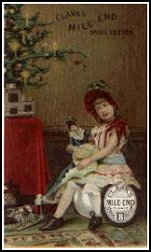
In the days of handstitched clothes and detailed tapestries
the thimble was highly valued by the needlewoman.
They have a long and fascinating history, yet many pay little attention to this tiny item hiding in the bottom of a sewing basket or at the back of a drawer.

 |
Click
here: Victorian Trade Cards |
 |
 |
